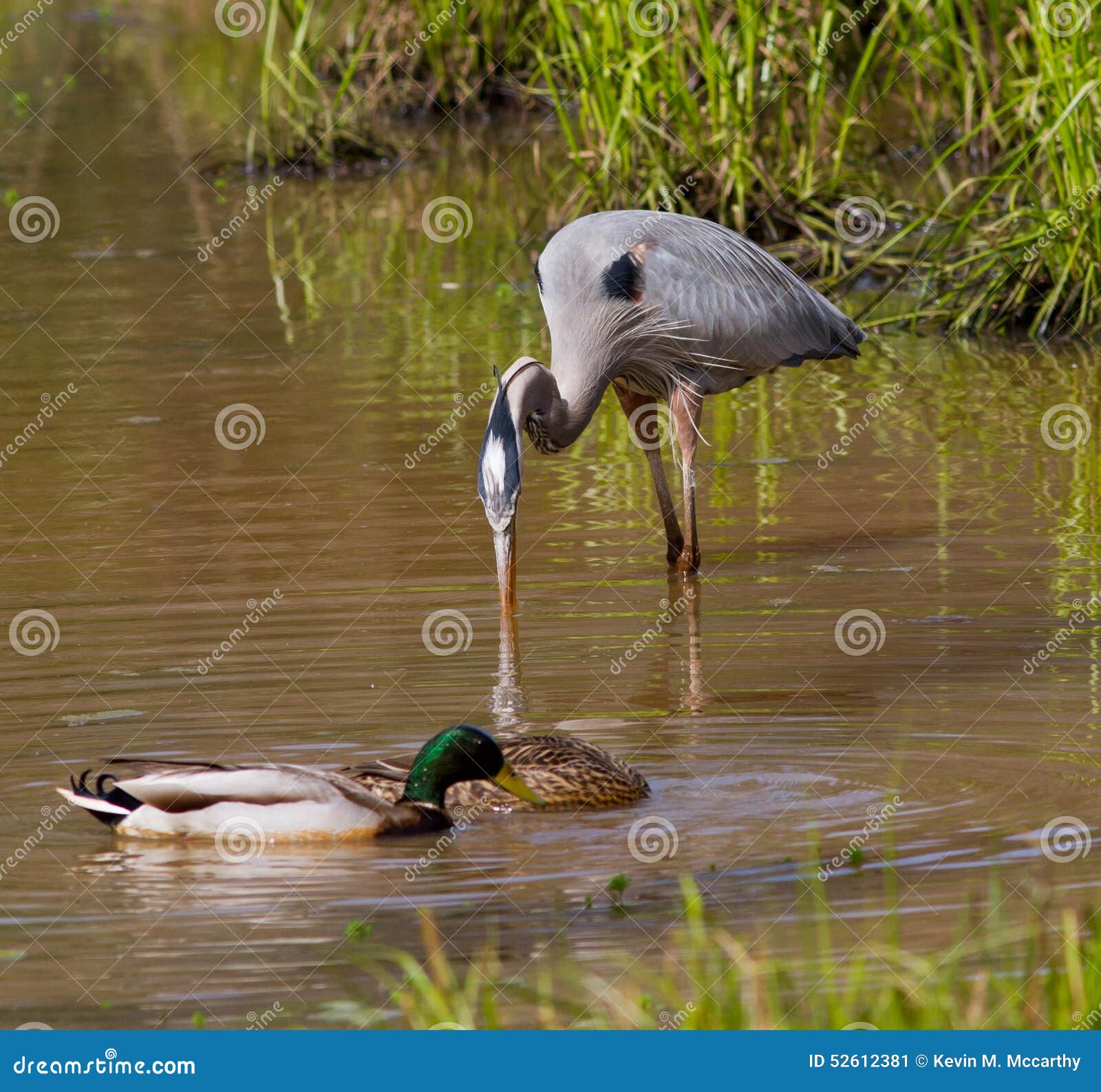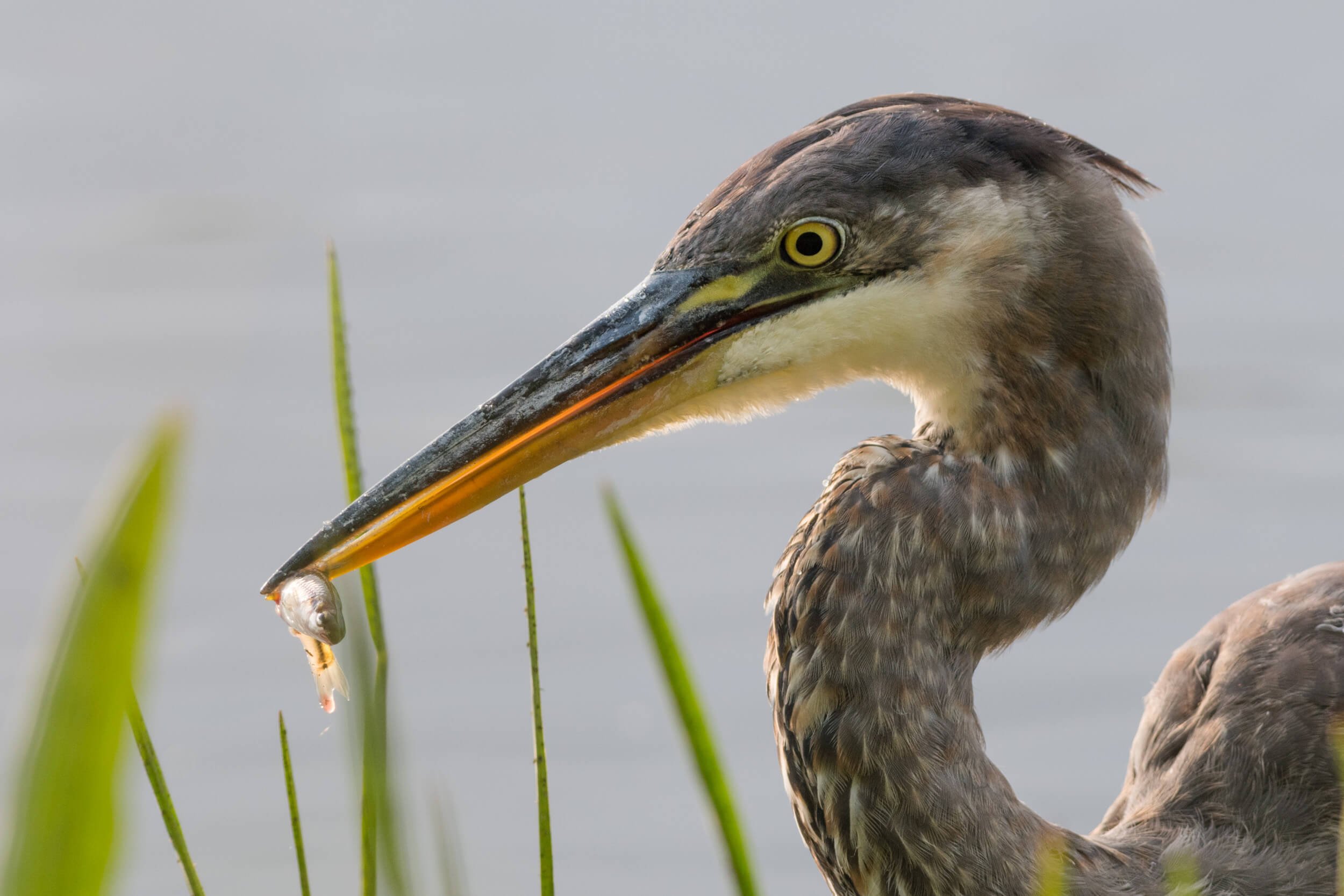Great Blue Heron Diet: What Do They Eat? Facts & FAQs
Do great blue herons pose a threat to the tranquility of your backyard pond? The answer is a resounding yes, especially for the youngest inhabitants, as these majestic birds are opportunistic predators, with ducklings often finding themselves on the heron's menu.
The great blue heron, a sight to behold with its impressive size and graceful demeanor, is a skilled hunter. They are not particularly picky eaters. While fish form the cornerstone of their diet, the heron is known for its adaptability, consuming anything from amphibians to rodents, snakes, and even other birds. The vulnerability of ducklings to these imposing hunters is a well-documented phenomenon. Herons will often position themselves near bodies of water, patiently waiting for an opportunity to strike. When the time is right, a swift, precise movement is all it takes for the heron to secure a meal.
The great blue heron's hunting prowess stems from a combination of keen eyesight and an almost surgical precision when striking. Some species of herons, including the great blue heron, are known to use their feet to stir the water, which helps to dislodge any hiding prey, increasing their chances of a successful hunt.
- Kaitlyn Krems Leaks Unpacking The Controversy Impact Explained
- Riley Greens Relationship Status Wife Girlfriend Dating Life
| Attribute | Details |
|---|---|
| Common Name | Great Blue Heron |
| Scientific Name | Ardea herodias |
| Size | Approximately 4.5 feet tall, with a wingspan of up to 7 feet |
| Weight | Around 8 pounds |
| Primary Diet | Fish (88% of diet), also consumes amphibians, reptiles, small mammals, birds, insects, and crustaceans. |
| Lifespan | Typically 15 years, with some individuals living up to 25 years. |
| Predators | Owls, coyotes, snakes, and crocodiles (primarily targeting young birds) |
| Habitat | Wetlands, marshes, ponds, lakes, and coastal areas across North America |
| Hunting Method | Stalking and waiting, often standing motionless in shallow water; also hunting from the air. |
| Conservation Status | Least Concern |
| Breeding Season | Early spring, typically laying 2-5 eggs between February and April |
Cornell Lab of Ornithology: Great Blue Heron Overview
The image of a great blue heron circling overhead, or making a low flyby over a pond, can be a stark reminder of the food chain at work. As the heron's shadow falls over the water, the vulnerability of young ducklings becomes immediately apparent. These small creatures, still learning to navigate their world, are easy targets for a hungry predator.
Herons, as opportunistic hunters, will seize any readily available prey. Baby ducks are often included as part of their meals. Even ducklings a few weeks old can be devoured by the blue heron. However, it is not the only factor. Herons feed on a wide variety of small prey. The great blue herons will eat a range of other animals, including mice and small rodents such as voles and rats.
- Hdhub4u Your Guide To Free Movies Risks To Avoid
- Park Boyoungs Relationship Timeline Dating History Rumors Explained
This behavior is further illustrated by the fact that blue herons will also take ducklings if they are accessible. This means that while a heron might not specifically target a healthy adult duck, a young, vulnerable duckling presents an easier meal. The mother duck, witnessing such events, is undoubtedly devastated.
This behavior is further illustrated by the fact that blue herons will also take ducklings if they are accessible. This means that while a heron might not specifically target a healthy adult duck, a young, vulnerable duckling presents an easier meal. The mother duck, witnessing such events, is undoubtedly devastated. And because many snake species live and hunt near the water or in marshy areas, its not uncommon at all for herons to swallow snakes as well.
The great blue heron is not only a skilled predator but also a survivor. In winter, when other food sources dwindle, they are resourceful hunters. They continue to pursue fish, even in the frozen environments. Herons often soar at great heights, using their keen eyesight to spot potential prey. They also eat rodents and small birds.
Herons are territorial, especially when it comes to hunting grounds. They gather in large numbers around open pools of water during the winter months, despite the fact that these birds tend to hunt and eat on their own for the majority of the time. Great blue herons may be seen chasing away other blue herons that are in competition with them on a regular basis.
While adult ducks are generally safe from predation by herons, their young ones are particularly vulnerable, especially in their first few weeks of life. Other animals besides herons also prey on ducklings, including owls, coyotes, snakes, crocodiles, and various other birds of prey.
The great blue heron is a fascinating creature with a significant role in its ecosystem. Understanding its behavior and dietary habits is key to appreciating its place in the natural world. They have been observed catching and consuming ducks, especially ducklings. These incidents are more opportunistic in nature, as herons are known to take advantage of vulnerable or easily accessible prey.
The great blue heron is a fascinating creature with a significant role in its ecosystem. Understanding its behavior and dietary habits is key to appreciating its place in the natural world. They have been observed catching and consuming ducks, especially ducklings. These incidents are more opportunistic in nature, as herons are known to take advantage of vulnerable or easily accessible prey.
In a world where survival often comes down to adaptability and resourcefulness, the great blue heron stands as a prime example of nature's efficiency. Whether it is a wriggling snake, a plump frog, or a naive duckling, the heron's ability to adapt and thrive is a testament to its place at the top of the food chain.
When it comes to what herons eat apart from fish:
- Great blue herons will also eat a range of other animals.
- For example mice and small rodents such as voles often make up a substantial part of their diet.
- Rats are sometimes included as well.
- Small birds, reptiles, amphibians, insects, worms, and crustaceans like crabs and shrimp are also consumed by hungry herons.
Some species of herons, such as the great blue heron, may even use their feet to stir the water and dislodge prey from the bottom. The great blue heron typically has an average lifespan of approximately 15 years, with the oldest known individual recorded at an impressive 23 to 25 years of age. Their typical mating season happens in early spring where they have two to five eggs between february and april.
- Ggwiththewap Latest Content Exclusive Updates Discover Now
- Lattos Parents Misti Pitts Shayne Stephens Untold Story

Great Blue Heron and Mallard Ducks Stock Image Image of shore, ardea

Great Blue Heron Eating A Duckling In Marshland Stock Photo 12748195

Great Blue Heron Eating